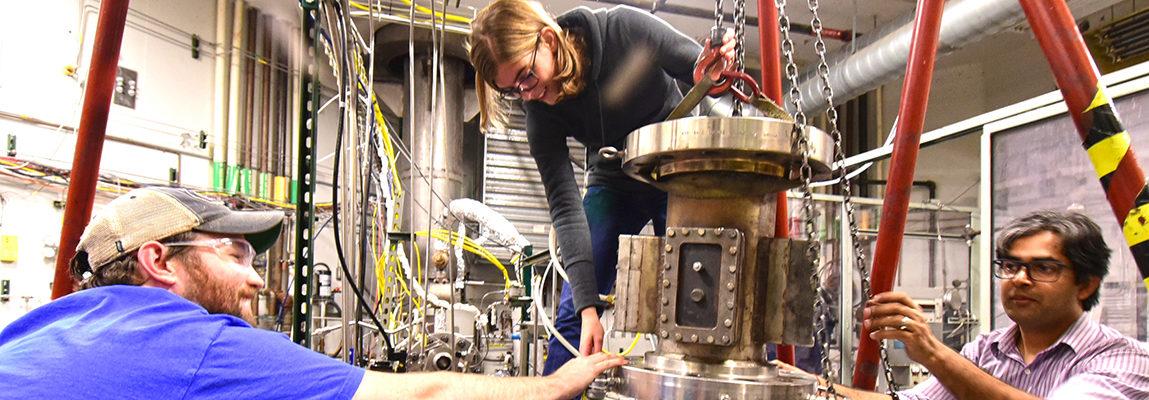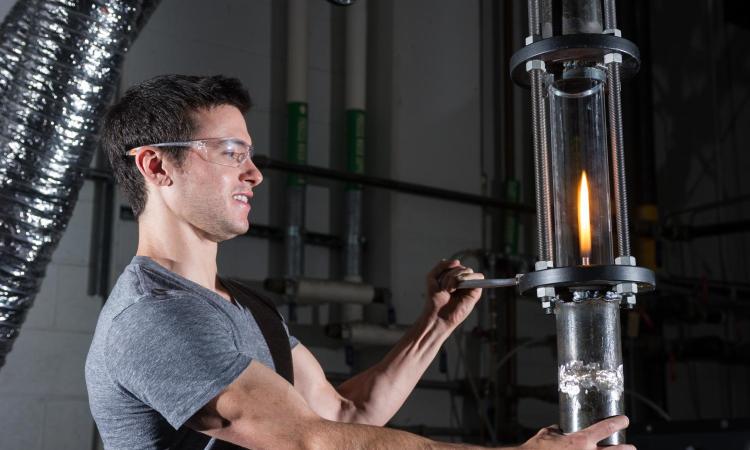Propulsion and Combustion

(text and background only visible when logged in)
Focus
The Georgia Tech AE Propulsion and Combustion Group (P&C) explores the complex systems that compose modern propulsion devices and energy systems. A multi-disciplinary team of faculty and students maintains world-class research, facilities, and academic programs that support this exploration. The group's work focuses on the interplay between complex fluid dynamics and high-temperature chemical and plasma energy conversion processes that underpin propulsion and energy systems.
The P&C group conducts basic, and applied research in combustion, chemical propulsion, and electric propulsion, employing experimental and computational approaches. Specific projects include unsteady phenomena in turbine engine combustors and liquid-fueled rocket engines; the development of nonintrusive, optical-based diagnostic and sensor techniques; the measurement and control of combustion emissions, alternative fuels, plasma-material interactions, facility effects and life limiting processes in electric propulsion devices, and efficient modeling of combustion phenomena at realistic conditions.
The P&C group actively collaborates with experts in other Georgia Tech schools, the Strategic Energy Institute (SEI), the Center for Space Technology and Research (C-STAR), and the Georgia Tech Research Institute (GTRI).
(text and background only visible when logged in)

Impact
The Georgia Tech AE Propulsion and Combustion Group (P&C) explores the complex systems that compose modern propulsion devices and energy systems. A multi-disciplinary team of faculty and students maintains world-class research, facilities, and academic programs that support this exploration. The group's work focuses on the interplay between complex fluid dynamics and high-temperature chemical and plasma energy conversion processes that underpin propulsion and energy systems.
The P&C group conducts basic, and applied research in combustion, chemical propulsion, and electric propulsion, employing experimental and computational approaches. Specific projects include unsteady phenomena in turbine engine combustors and liquid-fueled rocket engines; the development of nonintrusive, optical-based diagnostic and sensor techniques; the measurement and control of combustion emissions, alternative fuels, plasma-material interactions, facility effects and life limiting processes in electric propulsion devices, and efficient modeling of combustion phenomena at realistic conditions.
The P&C group actively collaborates with experts in other Georgia Tech schools, the Strategic Energy Institute (SEI), the Center for Space Technology and Research (C-STAR), and the Georgia Tech Research Institute (GTRI).
(text and background only visible when logged in)

Facilities
Central to the P&C group is the Ben T. Zinn Combustion Laboratory, a 13,000 ft2 facility located in the North Avenue Research Area. The experimental facilities are numerous and include: four high-pressure test areas for conducting large-scale combustion experiments, a high bay area for large vertical experiments, four light and sound isolation laboratories, and a large open test area. Modern measurement devices, including high-speed optical diagnostic techniques, are available and routinely employed. These facilities enable the group to investigate physical processes encountered in real propulsion and energy systems at relevant operation conditions.
Located in the Guggenheim building, the Computational Combustion Laboratory (CCL) includes several supercomputers, clusters, and workstations. The lab provides critical capacity for exploring turbulent, single- and two-phase combustion systems using large eddy simulations (LES). The computing capacity is able to process multi-scale parallel codes that simulate real-scale devices at relevant operating conditions. These codes can run on both Georgia Tech AE's network, and on larger computer clusters, such as are routinely used by our partners in the DOD, ONR, and DOE.
The High-Power Electric Propulsion Lab (HPEPL) brings together resources to explore high-power plasma propulsion and plasma physics at conditions representative of the on-orbit space environment. The 4,000 square foot infrastructure of the lab includes the largest diffusion-pumped vacuum facility at any university in the nation and it addresses research interests that involve light gases and high thermal loads. In addition, the cryopumped-vacuum facility possesses the highest xenon pumping speed at any University in the nation.
(text and background only visible when logged in)
Faculty
The AE faculty collaborating in the Propulsion & Combustion group are our most valued assets. Find out more about their background, accomplishments, and vision.
Get the full picture by finding out about all of the AE labs, collaborative groups, and centers
Download the P&C fact sheet (PDF).